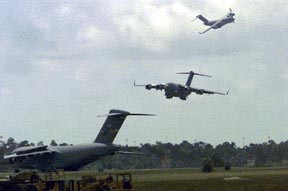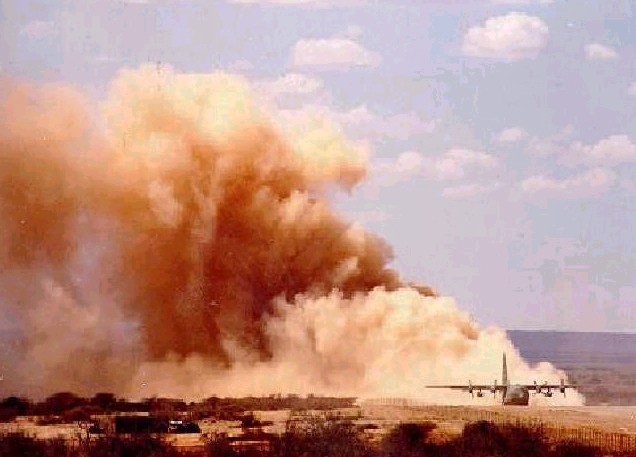AIRDROP BETTER THAN AIRLANDING!

FYI: Finally...a good article from Army Times....notice the time hacks for a Brigade Airdrop (30 minutes) beats airlanding a Brigade (29 hours) and beats the puny Mc MEU Battalion (6 hours--been there, done that).
By Matthew Cox
Moving at ground-breaking speed, Army leaders are engineering the Brigade Combat Teams at Fort Lewis, Wash., to be thrown into a fight and survive without support from heavy forces. But despite its versatility, the future fighting force may never leave the staging area unless Paratroopers open the door.
Chief of Staff Gen. Eric Shinseki's vision of blending the deployablity of light forces with the staying power of heavy outfits is sure to change the Army like never before. But students of ground warfare say it will be some time before the Army outgrows the need for Airborne units.
"My opinion of what the chief wants to do is ... it's exactly on target," said retired Gen. Carl Ernst, former commanding general for the Army's Infantry Center. "Anything that will lighten the Army and raise its technological advantage is a good thing.
"We still have to have the capability for a forcible-entry situation -- that is a hostile environment where we are not invited."
On the Special Operations side, the 75th Ranger Regiment makes up part of the Army's rapid-deployment force and can begin launching the first of its three Battalions on short-term strike operations within 18 hours. For more conventional operations, however, the 82nd Airborne Division still provides the main forced-entry capability for large-scale operations.
The Army's only true Airborne Division falls under the command of the XVIII Airborne Corps, designated after World War II to meet the rapid-deployment contingencies of the Cold War. Besides the 82nd, the Corps consists of the 101st Airborne (Air Assault), the 10th Mountain (Light) and the 3rd Infantry (Mechanized) Divisions, as well as the 2nd Armored Cavalry Regiment.
Like the Ranger Regiment, the 82nd can begin launching a Brigade-sized task force in 18 hours toward objectives anywhere in the world.
In the 1989 invasion of Panama, both units were sent in to spearhead a larger invasion force. The Rangers parachuted into Torrijos International Airport at 1 a.m. Dec. 20, followed by the 82nd 45 minutes later.
"If you want ground troops on the ground quickly, they are the only ones that can do it, unless the marines are lurking off shore," said Douglas Johnson, research professor at the Army War College's Strategic Studies Institute.
Once the airdrop begins, three Airborne infantry Battalions supported by artillery, air-defense artillery and engineer units can be on the ground in 30 minutes.
If the same-size unit were to airland on an airfield, it would take 29 hours to deploy its forces, said Col. Stephen Sittnick, director of plans for the XVIII Airborne Corps. "It's really hard to beat. How else can you put a Brigade-sized element on the ground -- there is no other way to get them there as fast."
By comparison, if a marine expeditionary unit were operating near the area, it could put a reinforced battalion of infantry with air support ashore within six hours.
But this capability to drop a Brigade in 30 minutes is by no means foolproof. In the early hours of Operation Just Cause, freezing rain at Fort Bragg, N.C., delayed the second lift of 10 C-141s from the 82nd from taking off by more than four hours.
After the airfield or landing zone has been secured, other units can be funneled in as needed.
"It's not only conducting a forcible-entry, you are going to have to have other forces follow," Sittnick said. "You have to be the type of unit that can work with other units. You are going to have to be the force that can absorb other forces and grow."
Shinseki's plan calls for his medium-weight Brigades to be on the ground within 96 hours, followed by the remainder of the Division in five days -- exactly what Airborne forces were designed to support, experts say.
"They can create the hole, create the lodgment, where these other forces can flow into," Ernst said. "This is where you get the complimentary aspect of what the chief wants."
But Airborne operations still have as much chance of having troubles as they did during World War II.
"What we saw in Normandy wherever the incoming aircraft encountered heavy flak, the drop was disrupted," Johnson said, describing how Paratroopers were often dropped miles from the drop zone. "Pilots can be as brave as they want, but when half a wing is shot off, you are not going to make the drop zone."
Today, a bigger threat is an army in an under-developed country with shoulder-fired missiles. "They lie in a foxhole, you fly over in formation and they knock the crap out of you," Johnson said. "And that is a major problem."
And once on the ground, lightly armed Paratroopers are always in danger of being cut off altogether if the enemy's air defense can't be controlled.
"The biggest danger is they get in safely and the enemy establishes an anti-air umbrella around them and over them," Johnson said. "When the other guy still has a significant air defense ability ... then that ability to aid and assist them is not too cool."
Airborne forces of the future may be able to combat some of these hazards with new technology such as the Enroute Mission Planning and Rehearsal System, which links headquarters elements in the rear to aircraft and all the way to the objective.
The system would allow an Airborne Task Force to revise its plan of attack using fresh intelligence via satellite.
"If you are going to fly 18 to 20 hours, you certainly don't want to be 18 to 20 hours old with your information," Ernst said.
The 82nd will conduct a formal test with the new system at Fort Polk, La., in September at the Joint Contingency Force Advanced Warfighting Experiment.
And while some hazards may never go away, experts continue to see the Airborne surviving the Army's latest round of transformation as well as the next.
"We will need them until we can figure a better way to deliver people with the same speed, and I don't see that in the next 10 years -- maybe in the next 30 years," Johnson said.
Army Times
Published: 08-14-00
Category: THIS WEEK
Page: 18
Airborne Units Land Fast, Hit Hard, Remain Relevant

HOOAH! pic but they are all in the WRONG CAMOUFLAGE!! Their parachutes, too!


The article doesn't mention the HUGE DUST SIGNATURE airlanding onto unimproved assault zones can give to help enemy targeting....airdrop eliminates this...
And the WEEK it takes to BUILD EVEN A DIRT AIRSTRIP and keep it functioning....
And as typical sit-on-their-asses, slacker, arrogant Airborne types of today who rest on the laurels of the great men who have gone on before them that unlike their forebears are clueless about IMPROVING THE AIRBORNE-- which takes RISK and imagination and COURAGE doing things like using SMOKESCREENS to mask airborne landings and to jump HIGHER with Russian-style drogue-activated parachutes to evade enemy MANPADS SAMs and once on the ground to use readily available M113 Gavin light tanks to transport Paratroopers and render superior shock action and firepower...
FEEDBACK!